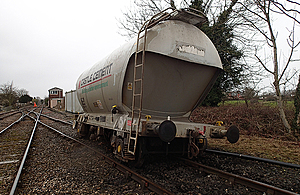
The incident happened at 8.20am on Monday 9 March when a cement powder-loaded tank wagon ran away from a siding within the Hanson Cement works in Clitheroe, Lancashire, North-West England.
The wagon left the works and continued to run away on the descent towards Horrocksford Junction, where the line to the cement works joins the main railway line from Blackburn to Hellifield.
As it ran away, the wagon broke through the gates at the exit from the cement works and ran over an open level crossing located on a road, causing two cars to stop.
Nobody was injured as a result of the incident.
An RAIB spokesperson said neither level crossing had its manually activated warning equipment switched on before the wagon passed over.
The spokesperson continued: "On reaching Horrocksford Junction, the wagon derailed at the end of the run-out rails for a set of trap points. The trap points worked as intended to prevent such unauthorised movements from reaching the main line. The derailed wagon stopped clear of the main line and no trains were nearby when the derailment occurred. The wagon ran away for a total distance of about 0.75 miles (1.2km).
"Our investigation will seek to identify the sequence of events which led to the accident. It will also consider any factors relevant to the performance and design of the wagon's braking system, how the risk of runaway wagons from within the cement works was controlled and any relevant underlying factors.
"Our investigation is independent of any investigation by the railway industry or by the industry's regulator, the Office of Rail and Road.
"We will publish our findings, including any recommendations to improve safety, at the conclusion of our investigation."








